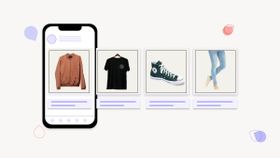What is Clickbait?
Published May 5, 2024.

Clickbait is a marketing and engagement strategy that employs sensationalist, misleading, or withholding content to lure clicks and boost page views. It's a tactic often seen on platforms like YouTube or in ads on news articles.
For instance, a YouTube video might have a title like "Why YouTube’s Biggest Star Quit (Liza Koshy interview)", promising intriguing insights.
While clickbait tactics may initially drive traffic to a website or video, they can ultimately undermine trust and credibility if users feel misled or disappointed by the actual content they encounter.
Clickbait often exploits the "curiosity gap," enticing clicks with vague questions or statements without delivering substantial content. This strategy aims to drive traffic to websites or blogs but may sacrifice quality for clicks.
Why do companies use clickbait?
Businesses use clickbait for various reasons. Some aim to boost website traffic and engagement, as clickbait can attract users to their content. Popular clickbait articles may even prompt social sharing, further extending their reach.
However, clickbait also has a darker side. Malicious entities often exploit this technique to promote scams, phishing sites, and malware. Consequently, internet users must exercise caution when encountering sensationalized headlines or misleading content.
To address the impact of clickbait, search engines like Google have updated their algorithms to penalize fake news, duplicate content, and pages created solely for generating clicks. These measures seek to mitigate the negative consequences of clickbait on online ecosystems and user experiences.
Pro tip: want to avoid clickbait and create high-quality social content? Talk to one of our vetted social media managers.
Which features define clickbait?
Clickbait is easy to spot because it has some obvious signs. Here are a few things that make it easy to understand:
- Tricky titles: Clickbait uses titles that promise something exciting or shocking but often don't deliver.
- Not much to read: Clickbait articles are usually short and don't give you much information. They're more about getting you to click than actually telling you something useful.
- Playing with your feelings: Clickbait tries to make you feel something, like curiosity or fear, to get you to click on it.
- Tricks to make you click: Clickbait might use things like quizzes or polls to get you to interact with it, even if it's not very interesting.
Examples of clickbait
Here are some great examples of clickbait.
Sensational headlines
Clickbait headlines often employ curiosity gaps, leaving out crucial information to provoke curiosity and entice clicks. For instance, a headline like "You Won't Believe What Happened Next!" creates intrigue by suggesting an unexpected or shocking outcome, prompting users to click to satisfy their curiosity.
However, the content behind such headlines may not live up to the sensational promise, leading to disappointment.
Thumbnail images
Thumbnails are crucial in attracting users' attention, especially on video-sharing platforms and social media feeds where visuals dominate. Clickbait thumbnails often feature exaggerated facial expressions, provocative imagery, or misleading graphics designed to grab attention.
These thumbnails may have little relevance to the actual content of the video or article, misleading users into clicking based on the visual appeal alone.
False promises
Clickbait often relies on making grandiose promises or offering quick solutions to common problems. For example, headlines like "This One Trick Will Make You Rich Overnight!" exploit people's desire for instant gratification and financial success.
However, the online content behind such clickbait often fails to deliver genuine value or practical insights, leading to disappointment and skepticism among users.
Sensationalism
Sensationalist language is a hallmark of clickbait, with headlines designed to shock or intrigue readers mainly on blog posts. Phrases like "Breaking News: Shocking Revelation About Celebrity X!" capitalize on people's fascination with celebrity gossip and scandalous revelations. However, the actual content may lack substance or credibility, relying on sensationalism to attract clicks rather than providing meaningful information.
Listicles
Listicles are a popular format for clickbait content, offering a series of intriguing or surprising facts to entice readers. For example, headlines like "10 Mind-Blowing Facts You Didn't Know About..." promise valuable insights or entertaining tidbits to encourage clicks. However, the content may prioritize quantity over quality, with shallow or trivial information presented in a clickbaity format to maximize engagement.
Manipulative Language
Clickbait often employs weird trick to play on people's insecurities or curiosity. For instance, headlines like "You're Probably Doing [Common Activity] Wrong!" suggest that readers may be making mistakes or missing out on important information.
By exploiting people's fear of being left behind or making errors, clickbait encourages clicks based on a sense of urgency or FOMO (fear of missing out).
Vague Teasers
Clickbait often relies on vague statements or cliffhangers to provoke curiosity and encourage clicks. Phrases like "You'll Never Guess What Happens Next!" create a curiosity gap, leaving readers eager to uncover the hidden information.
However, the content may fail to deliver on the initial promise, relying on clickbait tactics to drive traffic rather than providing substantive value or insights.
Fake News
In the most egregious cases, clickbait can lead to websites that spread false or fake news stories, exploiting people's curiosity or emotions for clicks and engagement. These websites often prioritize sensationalist headlines and provocative content over factual accuracy, spreading misinformation and undermining trust in credible sources.
Fake news clickbait can have serious consequences, influencing public opinion, and shaping perceptions on important issues.
Pros and cons of clickbait
Pros:
- Increased Click-through Rate (CTR): Clickbait titles often entice users to click on content, leading to higher CTRs and increased traffic to websites or platforms.
- Enhanced Engagement: Clickbait content may generate higher levels of engagement, such as likes, shares, and comments, as users interact with provocative or intriguing headlines.
- Potential for Virality: Clickbait has the potential to go viral on social media platforms, reaching a wider audience and increasing brand visibility.
- Opportunity for Brand Exposure: Clickbait can help brands gain exposure and attract new followers or customers by capturing users' attention and directing them to their content.
Cons:
- Loss of Trust: Clickbait often fails to deliver on its promises, leading to a loss of trust among users who feel misled or deceived by exaggerated or misleading headlines.
- Negative Brand Perception: Brands that consistently use clickbait tactics may be perceived negatively by users who view such practices as manipulative or dishonest.
- High Bounce Rates: Clickbait content may result in high bounce rates, as users quickly navigate away from the webpage or platform after realizing the content does not meet their expectations.
- Damaged Reputation: Continual use of clickbait can damage a brand's reputation and credibility, as users become wary of engaging with content from that source due to previous disappointments.
Does clickbait work?
Yes, clickbait can be effective. It capitalizes on human curiosity, emotional triggers, and visual appeal to drive clicks and engagement. Clickbait enables users to click on links or engage with content by creating attention-grabbing headlines and thumbnails. Its short, easily digestible format makes it appealing in today's fast-paced digital landscape.
However, clickbait's effectiveness is often short-lived. While it may drive initial clicks and engagement, it can lead to negative user experiences when content fails to deliver on its promises. This can result in a loss of trust and credibility for publishers or platforms.
Social media platforms and algorithms are increasingly cracking down on clickbait. Many implement measures to detect and penalize clickbait tactics, such as reducing the visibility of clickbait content in news feeds or search results.
Publishers need to focus on creating valuable, authentic content that genuinely resonates with their audience which is what we will discuss next!
How to break the habit and build lasting audience engagement
You might have used clickbait - flashy stuff that promises a lot but doesn't deliver much. To connect with your audience and make them stick around, it's better to focus on making content that's real and helpful.
Here are a few easy ways to do that:
- Understand Your Target Audience: Conduct thorough audience research to understand their interests, preferences, and pain points. Use analytics tools, surveys, and social media insights to gather data on your audience demographics, behaviour, and engagement patterns. Tailor your content to address their needs and interests effectively.
- Focus on Quality Over Quantity: Instead of churning out clickbait content for short-term gains, prioritize quality over quantity. Invest time and resources into creating well-researched, informative, and engaging content that provides genuine value to your audience. Ensure that your piece of content is accurate, credible, and unique, offering insights, solutions, or entertainment that cannot be found elsewhere.
- Build Community Engagement: Foster a sense of community and belonging among your audience by encouraging interaction, dialogue, and participation. Create opportunities for audience engagement through comments, polls, contests, and live events. Respond promptly to comments and messages, and actively participate in discussions to show that you value your audience's input and feedback.
- Establish Trust and Credibility: Build trust and credibility with your audience by being transparent, honest, and authentic in your communication. Avoid clickbait tactics and misleading promises, and strive to provide accurate headlines, and reliable information that adds value to your audience's lives. Showcase your expertise and authority in your niche by sharing insightful, well-researched content that demonstrates your knowledge and expertise.
- Offer Personalized Experiences: Tailor your content and communication to individual audience members' preferences and interests whenever possible. Use segmentation and personalization techniques to deliver targeted content recommendations, recommendations, and offers based on user behavior, preferences, and demographics. By providing personalized experiences, you can enhance engagement and foster stronger connections with your audience.







